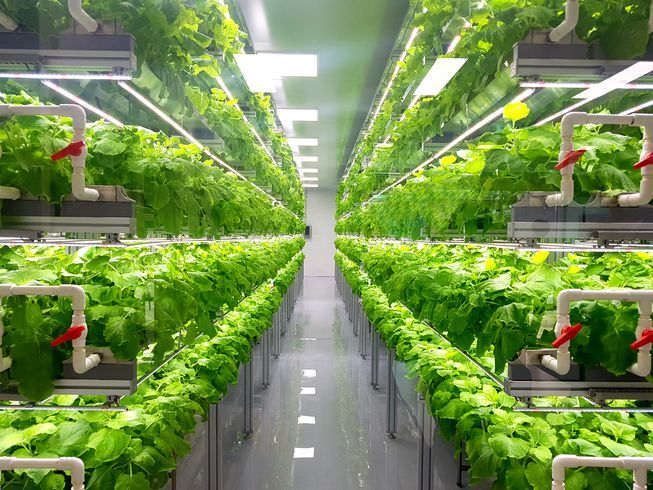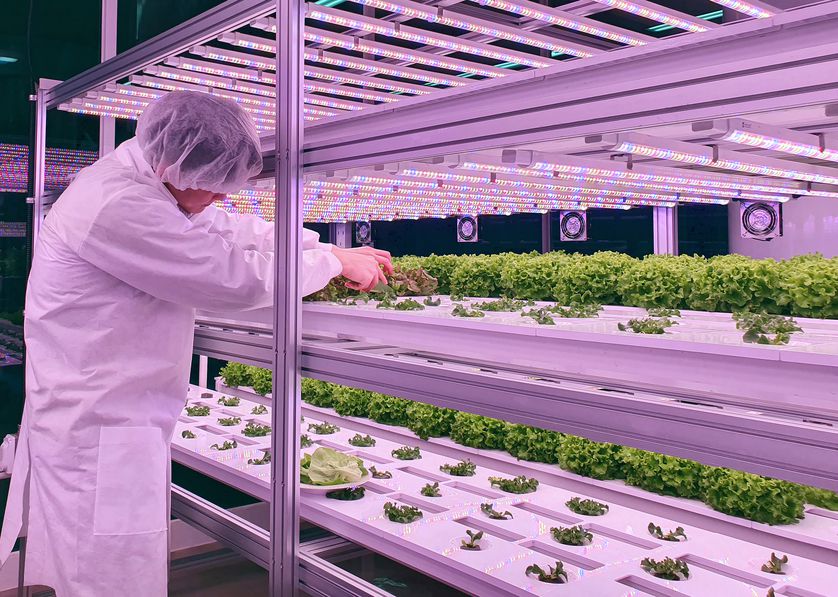为什么室内农业运动正在兴起
为什么室内农业运动正在兴起
As the world emerges from a pandemic that has kept about one in five people in their homes for weeks, it's little surprise that the idea of indoor farming is gaining traction. After all, we've had a lot of time to think about what we can do indoors — and maybe even ponder what we may have done outdoors that contributed to this mess.
随着世界从一场让五分之一的人在家里待上数周的大流行中走出来,室内种植的想法获得越来越多的关注也就不足为奇了。毕竟,我们有很多时间考虑我们在室内可以做什么,甚至可能考虑我们在室外可能做了什么导致了这种混乱。

No soil. No sun. No problem. (Photo: Yein Jeon/Shutterstock)
Indoor farming, on the other hand, isn't as land intensive. In fact, new technologies and advancements in hydroponics are making it possible to grow crops without pesticides, soil or even natural light. And since indoor crops can be stacked vertically, there's no need for vast tracts of land. Imagine farms as downtown office towers, offering floor after floor of fresh produce.
另一方面,室内种植不需要大量土地。事实上,新技术和水培技术的进步使种植农作物不使用杀虫剂、土壤甚至自然光成为可能。由于室内作物可以垂直堆放,所以不需要大片土地。把农场想象成市中心的办公大楼,提供一层又一层的新鲜农产品。
Farming takes a bite out of wilderness
农业使荒野少了几分荒凉
At first blush, it may seem like an unlikely partnership. What does an organization dedicated to wilderness preservation have to do with the development of farms? But part of the WWF's mandate is to find ways to reduce the environmental imprint of growing food, especially since vital habitats like forests are often cleared to make space for farmland.
乍一看,这似乎是一种不太可能的合作关系。一个致力于荒野保护的组织与农场的发展有什么关系?但是,世界自然基金会的部分任务是找到减少粮食种植对环境的影响的方法,特别是在重要的栖息地,如森林,经常被清除,为农田腾出空间的情况下。

Advances in hydroponics and technology have made it possible to grow more of our food indoors. (Photo: Yein Jeon/Shutterstock)
But will indoor crops — whether housed in sky-spanning towers or intricate caves — ever fully replace their outdoor counterparts as breadbasket to the world?
但是,室内作物——无论是生长在摩天大楼里还是错综复杂的洞穴里——是否会完全取代室外作物,成为世界的粮仓呢?
Probably not. Even vertical farms stacked as high as skyscrapers will eventually run into the same space constraints — unless, of course, we find a way to stack them to the moon. And we're just talking about a perfect vegetarian world here. No one is thinking about confining animals to caves and towers.
可能不会。即使是像摩天大楼一样高的垂直农场最终也会遇到同样的空间限制——当然,除非我们找到一种方法把它们堆到月球上去。我们在这里谈论的是一个完美的素食世界。没有人会考虑把动物关在洞穴和高塔里。
Besides, we're all relatively new to the trade. After all, humans don't have a lot of experience growing their food indoors like they do with traditional farming.
此外,我们都是这一行的新手。毕竟,人类不像传统农业那样有很多在室内种植食物的经验。
But indoor operations may be able to ease at least some of the pressure industrial farming puts on our sorely overtaxed Earth.
但是,室内作业至少可以部分缓解工业化农业给我们不堪重负的地球带来的压力。
The grow-your-own food movement
自己种植食物运动
The best part about an indoor farming revolution may be that it's already begun — with individuals. The lockdown has seen a massive surge in the grow-your-own food movement, as people look not only for something to do with their time but also reduce their reliance on grocery stores.
室内农业革命最好的部分可能是它已经开始了——从个人开始。由于人们不仅在寻找打发时间的方式,还减少了对杂货店的依赖,“自己种植食物”运动在全国掀起了一股热潮。
In the U.S., as Mashable reports, garden centers and seed delivery services have seen sales grow 10-fold during the pandemic, with Walmart selling out of seeds completely.
据互联网新闻博客Mashable报道,在美国流感大流行期间,园艺中心和种子配送服务的销售额增长了10倍,沃尔玛的种子全部售罄。
There's much breathless enthusiasm, and understandable optimism, to the indoor movement as people look to do things a little differently in the post-pandemic era.
在大流行后的时代,人们希望以稍微不同的方式做事,室内运动有许多令人窒息的热情和可以理解的乐观。
"Thanks to giant leaps forward in the science of hydroponics and LED lighting, even people in windowless, gardenless apartments can participate in the revolution," writes Chris Taylor in Mashable. "With a number of high-tech consumer products on the way, the process can be automated for those of us without green thumbs."
克里斯•泰勒在Mashable网站上写道:“由于水培技术和LED照明技术的巨大飞跃,即使是住在没有窗户、没有花园的公寓里的人也能参与到这场革命中来。”“随着一系列高科技消费品的推出,这一过程可以自动化,为我们这些没有绿色拇指的人服务。”
And some farmers, like Benjamin Widmar, didn't need a pandemic to be the change he wanted to see. He's trying to grow enough tomatoes, onions, chillies and microgreens to meet an entire town's needs. All from his indoor farm in Norway's Svalbard archipelago, about 650 miles south of the North Pole.
有些农民,比如本杰明·威德马,并不需要大流行来实现他想看到的改变。他试图种植足够的西红柿、洋葱、辣椒和微型蔬菜来满足整个城镇的需求。这些都来自他在挪威斯瓦尔巴群岛的室内农场,该群岛位于北极以南约650英里处。
"We're on a mission … to make this town very sustainable," he tells the Thomson Reuters Foundation. "Because if we can do it here, then what's everybody else's excuse?"
他对汤森路透基金会表示:“我们的使命是……让这座城市变得非常可持续。因为如果我们能在这里做到,那么其他人的借口是什么?”
- 频道推荐
- |
- 全站推荐
- 推荐下载
- 网站推荐


















